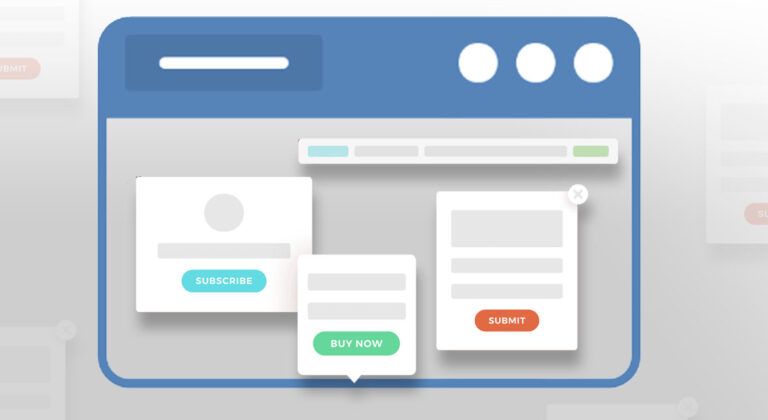11 Benefits of Conversion Rate Optimization and Best Practices

I hope you enjoy this blog post. If you want Hello Bar to grow your leads, click here.
Author:
Ryan Bettencourt
Published
July 24, 2024
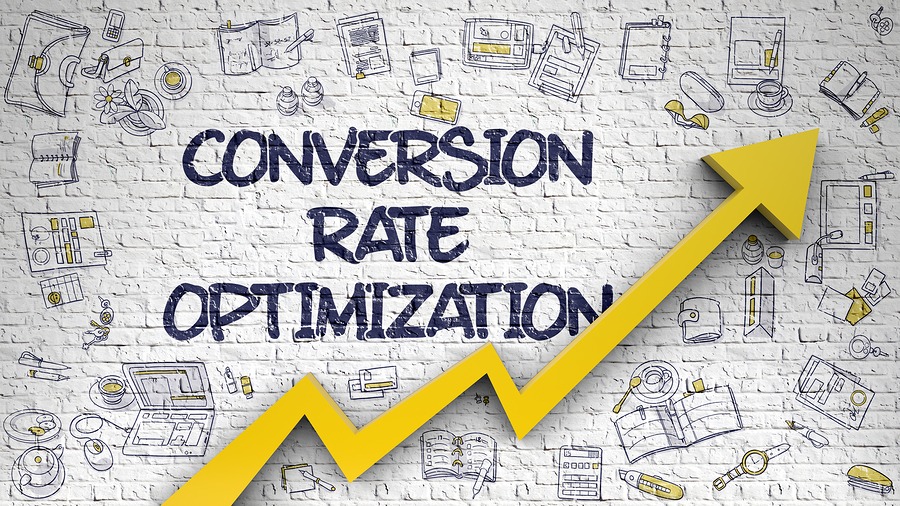
Conversion rate optimization, or CRO, has become one of the top pursuits for marketers everywhere. Boosting conversion rates can have a huge impact on your bottom line, so there are tons of benefits of conversion rate optimization.
However, before you can pursue a CRO strategy, you need to understand exactly what it is, how it works, and how to evaluate it. There’s plenty of testing involved in true CRO, so you’re in for the long haul.
Don’t let that scare you, though. Dedicating yourself to CRO can make your business more profitable and your marketing strategy more scalable.
Plus, once you start the process, you might find that you can’t stop. It’s highly engaging because you get to watch your metrics improve steadily over time.
In addition to providing you with a primer on the benefits of conversion rate optimization, we’re also going to share with you 11 advantages that can help your business succeed.
What is the Meaning of Conversion Rate?
Your conversion rate is the percentage of potential customers who take the desired action out of the total number of consumers who interact with your offer.
For instance, you put up a sign that says “Try our new cupcakes! 10% off!” (This is your offer). Throughout the day, 100 people walk by your display (these are your interactions). Out of those 100 people, 15 decide to buy a cupcake (these are your conversions).
Your conversion rate is the percentage of those that decided to buy your cupcakes out of the total interactions.
In this context, you can calculate your conversion rate for lots of things:
- Sales
- Email signups
- Poll and survey participants
- Webinar registrations
Of course, sales is the most important metric to track, but conversion rates on actions like email signups, email open rates, and webinar registrations can help you quantify your lead-generation results.
It’s easy to calculate conversion rate. Let’s say you want to know your average conversion rate on sales.
Divide your total sales by your total site visits, then multiply the result by 100.

You can do the same for any other conversion rate. Just replace the total transactions by the total email signups, webinar attendees, or any other metric. You can also replace the total site visits with the total page visits for a given web page.
You May Also Like:
- 12 Lead Generation Strategies That Will Greatly Increase Conversions
- Data-Driven? How To Calculate Your Lead Conversion Rate
What is Conversion Optimization for Websites?
Once you know your conversion rate, you’ll want to increase it. That’s natural. Conversion rate optimization (CRO) refers to the process of improving every element of your website so you can boost conversions.
The smallest thing can impact your conversion rate. For instance, the background color of your CTA button might convince people to convert or fail to grab them altogether. A/B test different colors to figure out which works best with your audience.


You see this all the time in brick-and-mortar stores. Shopkeepers use end caps, for instance, to highlight products they want to sell. They might include a big sign that advertises a discount for those products.
Since end caps receive more visibility than longer shelves, they’re more likely to attract shoppers.
This same concept applies to your website. The benefits of conversion rate optimization include more sales because you’re ushering buyers toward the desired goal.
It’s also a guessing game — at least at first. When you first start the CRO process, you don’t know what will resonate with your audience, so you make an educated guess.
As you collect data, though, your guesses become more rooted in fact. You start to understand your audience and its needs and desires, which makes serving up the right offer at the right time much easier.
Why is Conversion Rate Important?

Benchmarks are essential for any business. We’re going to get into the benefits of conversion rate optimization shortly, but first, you need to know why you’re measuring your conversion rate in the first place.
Imagine for a moment that you own a buffet restaurant. You serve numerous dishes in warming pans in the center of the restaurant, and guests self-serve whatever they want.
If you’re not paying attention, you could easily run your business into the ground.
For instance, if you make tilapia and put it in a warming pan for guests to eat, you want to know how many of your guests actually eat a tilapia fillet. If nobody eats a tilapia fillet, you’re spending money on fish that winds up in the garbage.
Each time someone plates a tilapia fillet, that’s a conversion. Your customer has seen and accepted the offer. Therefore, you’ve made money on that fillet. Ideally, you want to know what ratio of customers takes a tilapia fillet so you know how many to make each night without wasting money.
It’s the same thing with websites. You need to know how many people accept your offer compared to the number of people who visit your website.
Best Metrics to Help You Analyze Conversion Rate Optimization
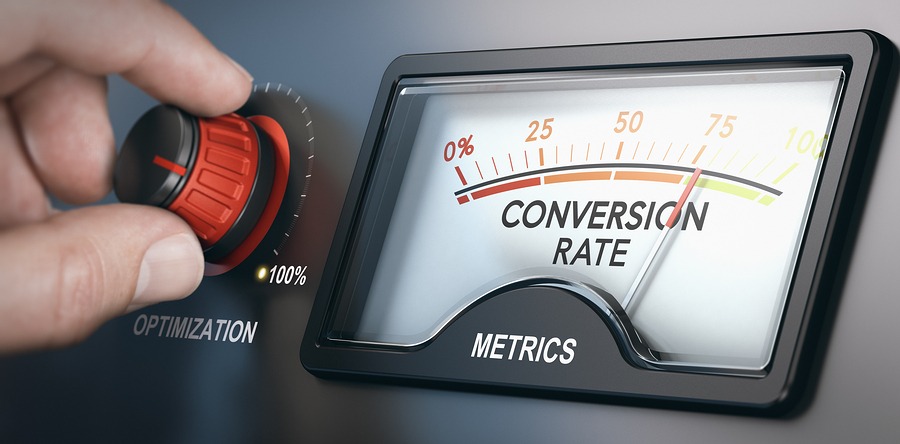
You can use the equation we described above to calculate your conversion rate, but that’s not the whole story. If you’re basing all of your decisions solely on conversion rate, you’re missing out on potential profits.
When you manage a restaurant business, for instance, it’s not enough to know how many people convert on the dishes you offer. You also need to know how much each customer spends in your restaurant, how many drinks they consume, and other metrics.
The same goes for an online business. You need to know the bigger picture if you want to maximize profits.
Customer Lifetime Value
How much money does your average customer spend on your business throughout the lifespan of his or her relationship with you? This is essentially what customer lifetime value is about.
If a customer buys one item valued at $99 and never comes back, his or her lifetime value is $99.
If that same person buys a $99 product every year for ten years, his or her customer lifetime value becomes $990.
Ideally, you want to convert high-value customers who will stick around for the long term.
You also need to track value per visitor.
Let’s say that 1,000 people visit your website in a week. Thirty of those people buy $99 products. However, you can’t just take into consideration those 30 people.
Your value per visitor is the total value of transactions over that period ($2,970) divided by the total number of website visitors (1,000). That brings the total value per visitor to $2.97.
Conversion Rate Optimization Best Practices
Before we talk about the benefits of conversion rate optimization, let’s discuss how to get your conversion rate up. These best practices will help you convince more people to convert on your offers.
Reduce Form Fields to Boost Conversions
Long, drawn-out forms are a real mood killer when it comes to conversion. Your prospects want to take advantage of your offer, but if you make them work too hard for it, they’ll disappear.
There’s a simple rule to follow for lead capture pages and forms: Only ask for the information that’s absolutely necessary for your business. If it’s non-essential, remove it.
On the Hello Bar homepage, for instance, we ask visitors to fill in just one field.

It’s simple and gets the ball rolling. People don’t feel intimidated.
This is especially essential when asking for email signups and when processing sales. These two bottlenecks can have a drastic impact on conversions.
For instance, if you want people to subscribe to your newsletter, all you really need is their email addresses. You can ask for their first names if you like to personalize emails, but that’s it.
For sales, you need their names and payment information. That’s all. If you request more information, you run the risk of shopping cart abandonment.
Test Your Calls To Action to Maximize Conversions
CTAs are essential when it comes to CRO. A call to action should inspire people to act — hence the name.
Specific, value-driven CTAs often work best. Don’t be coy. Tell your visitors exactly what you want them to do.
For instance, let’s say we’re running a site-wide sale for our ecommerce online. We might use a Hello Bar like this to sweep visitors into the shopping area of the site and to remind them they’ll be getting a deal:

Your CTA should reflect exactly how you want visitors to proceed. A declarative statement like “Shop Now” leaves no room for misunderstandings.
You can follow a similar methodology if you want to use your Hello Bar to increase email signups. Use a headline that puts your offer on the table, then follow up with a compelling CTA.

Since Hello Bar is GDPR compliant, you can also use Hello Bar to get opt-ins for your email list that don’t violate the EU’s rules.
Craft a Clear Headline to Increase Conversions
Headlines are invaluable for copywriting and marketing. The better your headline, the greater the chances of converting your visitor.
Many people will only read your headline. If it doesn’t move them to act, they’ll slip through your digital fingers.
A Hello Bar gives you the ideal opportunity to A/B test different headlines. For instance, you might start an A/B test with these two Hello Bars:


They’re extremely similar, as I’m sure you noticed. The CTA remains the same. I’ve just adjusted the wording of the headline offer.
Run several A/B tests over periods of weeks, months, and even years. As your audience changes, you’ll need to change with them. Testing different headlines is a great way to start enjoying the benefits of conversion rate optimization.
Create a Sense of Urgency to Optimize Your Conversion Rate
Urgency is one of the most powerful psychological triggers used in marketing today. We feel urgency on a daily basis, so it’s a familiar emotion.
Urgent deadlines. Urgent phone calls. Urgent letters. Urgent homework assignments.
Who doesn’t feel the heat of urgency on a daily basis?
Use this in your marketing to convince people to convert faster — before they have time to come up with objections, questions, and excuses.
An exit popup can work well for this purpose. When someone tries to leave your site, give them one more opportunity to convert. If you incentivize conversion, you’ll have better luck.
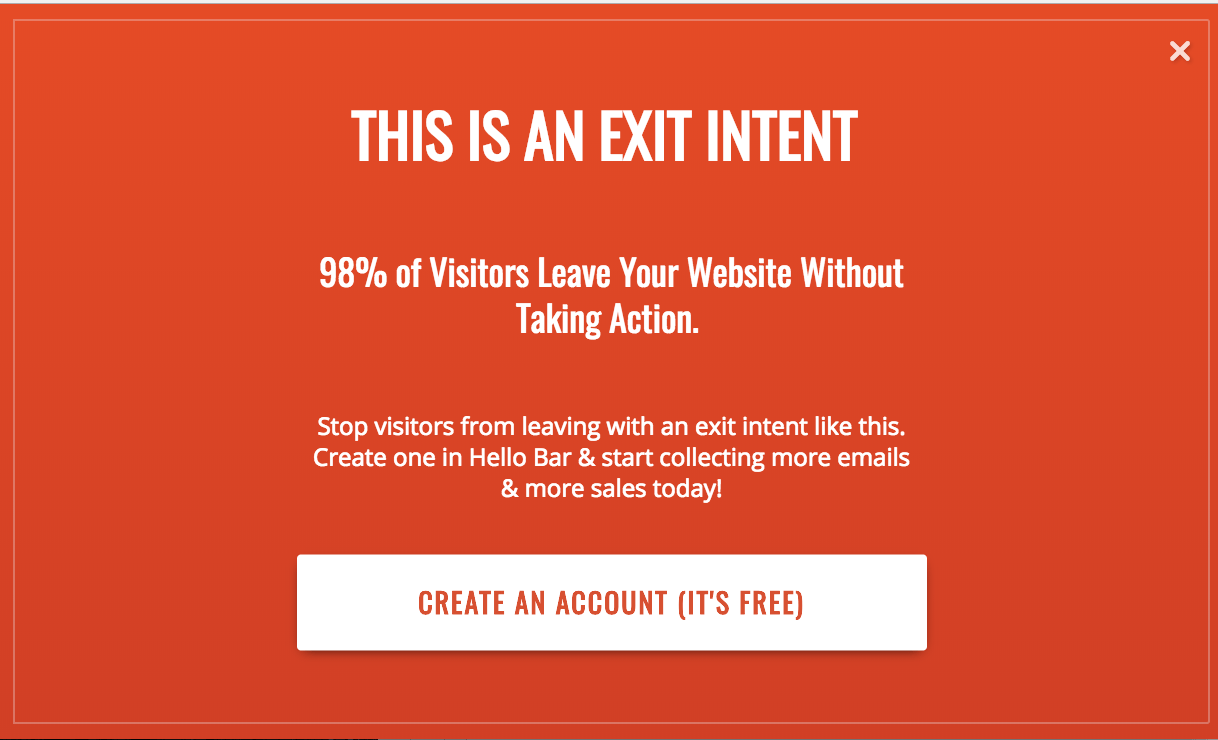
For instance, if you’re running an e-commerce shop, you might offer a coupon code if the visitor sticks around. Maybe they weren’t impressed with a product’s price, but now that they have a better offer, they might buy.
As we explain in our own exit popup on Hello Bar, most of your visitors don’t stick around. They “bounce” away before converting. You want to lure them back.
Add a Lot of Value to Your Final Offer
Value is subjective. What one person finds valuable, another considers garbage. That’s why it’s critical to get to know your audience if you want to reap the benefits of conversion rate optimization.
Think about your target customer. Imagine him or her in your mind. Come up with a list of wants, needs, desires, circumstances, and frustrations. What would convince him or her to sign up for your email list, buy your product, subscribe to your service, or attend your webinar?
Buyer personas are extremely handy tools. You probably have several of them, so you need a crafty offer for each.
Budget-conscious Brenda might appreciate a coupon code, while Rushed Ross could prefer a template or other tool to help him get things done faster.
You can also use the slow-build technique. In other words, your first offer doesn’t have to be your final offer.
You might use a Hello Bar to ask people to subscribe to your email list. Mention that subscribers get free weekly tips.
Then, add an exit intent popup that invites visitors to subscribe again. This time, sweeten the pot. Offer a limited-time coupon code for people who sign up.
Use Great Popups to Get More Leads and Get the Most of Your Website Traffic
Most popups don’t work. There are several reasons for this.
First, they’re annoying. It’s kind of like those people who stand on the side of the road, waving signs or placards at passing traffic. We mostly ignore them because they’re irritating.
But maybe one of those signs caught your attention. You needed whatever service or product was advertised, and the offer was too good to pass up. Suddenly, an annoyance becomes a blessing in disguise.
Popups also fail to work because they don’t actually grab visitors’ attention. They’re boring, irrelevant, or unattractive. People simply ignore them.
Knowing this, you can create a popup that works. Make it visually appealing and don’t waste your visitors’ time on an offer that won’t resonate.
Add Trust Badges to Your Website
Trust badges let your visitors know you value their privacy and security. They show you’ve taken extra steps to protect them.
An SSL certificate is one example. It’s essential if you’re selling products or services online, and it tells people that their information is encrypted. Just be sure to implement SSL monitoring to check for certificate validity.

Plenty of other trust badges exist. Explore options in your industry to find out which ones you need to put your visitors’ fears to rest.
You May Also Like:
- Best 43 Call-to-Action Phrases Proven To Increase Clicks and Leads
- Website Conversion Optimization: How to Get Results With A/B Testing (& Actual Examples To Get You Started)
11 Benefits of Conversion Rate Optimization
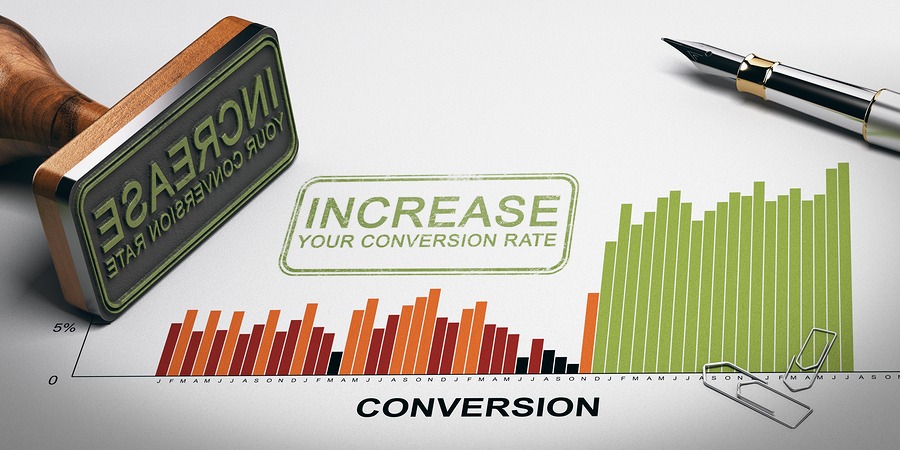
Now, we get to the good stuff. What do you get when you jump through all these CRO hoops? Why are you bothering with all this testing and optimization?
The benefits of conversion rate optimization are practically limitless, but for the sake of your eyes, we’re distilling them down into 11 of the most important. We know you’re anxious to implement all these ideas on your own website.
Without further ado, following are the top 11 benefits of conversion rate optimization.
1. Get to Know Your Customers
The more you dive into conversion rate optimization, the more you’ll learn about your customers. What do they want? What do they need? Why do they visit your site?
You’ll discover the answers to these questions primarily through questions, which, as we’ve discussed, form the basis for much of CRO. When you test various aspects of your website’s functionality, users will lend their “vote.” From the results, you can deduce what makes your target audience tick.
2. Boost Website Revenue
Speaking of revenue, who doesn’t want more sales? The more money you make, the stronger your business becomes.
Invest some of that cash back into the business. Run ads based on what you’ve learned about your audience. Keep people coming back for more.
You can also start optimizing for the metrics we described earlier. Do you want to increase customer lifetime value? Find ways to get those people to spend more money on your business.
3. Leverage Existing Web Traffic
Growth hacking is all about taking advantage of your existing assets. Your web traffic is one of them.
If people are already visiting your website, you want them to convert. Use tools like Hello Bar, Crazy Egg, and Google Analytics to anticipate what they’ll do when they arrive.
4. Lower Your Customer Acquisition Costs
Customer lifetime value matters more than you think because it’s less expensive to retain a customer who already exists than to acquire a new one. Furthermore, you want to measure the CAC and its effectiveness in spending as little as possible to bring more customers on board.
5. Improve Your Website Search Engine Ranking to Improve Website Conversion Rate
Our business partner, Neil Patel, has written hundreds of thousands of words about search engine optimization, or SEO. Why? Because it’s one of the most critical factors for businesses today.
If people can’t find you via search engines, how can they buy your products or services? You need to focus on primary keywords and optimizing every page of your site so you appear higher in the search engine results pages.
6. Increase Customers’ Lifetime Value
You knew we’d circle back to this again, right? It’s one of the most critical metrics you’ll ever measure.
How do you increase CLV? Offer bundles of your products so people spend more money. Invite them back via email marketing, engage with them on social media (Twitter, Facebook, Instagram, Pinterest, Youtube, etc), and host big product launches.
Don’t forget about customer support. If you’re there to guide your clients through every step of the customer journey, they’ll return.
7. Make Decisions Based on Proven Data
When it comes to making money, we don’t want to guess. We want to know. We’re pretty sure you feel the same way.
When you have hard data, you can make better decisions.
8. Take More Calculated Risks
With that said, we couldn’t succeed in business without taking risks. However, we want to hedge our bets so our risks pay off.
CRO lets you better understand your business and customers. You can take calculated risks because you’re more secure thanks to higher revenue and because you have a consistent stream of traffic on which to experiment.
9. Make Your Paid Advertising Campaigns More Profitable
As your business grows and your CRO improves, you’ll likely want to start advertising. Social ads, in particular, are extremely beneficial for businesses in most industries. You might also want to test paid search.
Armed with the data from your organic marketing campaigns, you can create more targeted ads. The cycle of success continues.
10. Get More Leads for Your Business
CRO also improves your lead-generation results. You’ll capture more information about your visitors so you can market to them over time.
11. Enhance Your Website Trust
Trust is almost like currency. If you don’t have it, you’re broke.
Consistent marketing builds trust. Your customers learn what to expect from you, and you never let them down.
Plus, you’ll seem to have a crystal ball because you’ll know when and how to target your visitors and customers with the right offers.
You May Also Like:
- 4 Proven Methods to 5x Your Conversion Rate
- 21 Proven Exit Popup Formulas That Will Increase Conversion Rates
FAQs
Q1. What are the benefits of conversion rate optimization?
Here are several benefits of conversion rate optimization:
- Increased Revenue: More conversions result in increased sales and revenue..
- Better Customer Insights: CRO provides valuable insights into what drives conversions and how to better serve your audience.
- Lower Customer Acquisition Costs: Increased conversions from your existing website traffic reduces the need to spend more on acquiring new visitors.
- Improved Search Engine Rankings: Improved user experience and higher engagement rates can lead to better search engine rankings.
Q2. Why is it important to optimize for conversions?
Optimizing for conversions maximizes your return on investment (ROI) by turning more website visitors into paying customers. It also enhances the user experience, leading to higher user satisfaction and loyalty.
Q3. What are the best practices for optimizing website conversion rates?
Here are some best practices for website CRO:
- Simplify Form Fields: Reduce the number of fields in your forms to make it easier for website visitors to complete them.
- A/B Test CTAs: Continuously test different call-to-action (CTA) buttons to determine which versions perform best.
- Add Trust Badges: Display trust signals like security certificates to increase confidence in your business.
Q4. Is conversion rate optimization worth it?
Yes. Conversion rate optimization is worth your while. It maximizes the value of your existing traffic, improves user experience, and increases revenue without additional marketing spend.
Q5. What does a conversion rate optimization specialist do?
A CRO specialist helps businesses optimize their websites for conversions. They analyze website data and user behavior to identify areas for improvement. They conduct A/B tests, optimize landing pages, enhance user experience, and continuously monitor and refine CRO efforts.
Conclusion
The benefits of conversion rate optimization are numerous. I’ve shared 11 of the most important benefits here.
CRO refers to the process of optimizing every aspect of your website and customer communications for conversion. You want more of your existing traffic to convert on your offers.
If you’re not measuring conversion rate, you’re missing out. You need to know what percentage of your website traffic actually engages with your business. Otherwise, you won’t know what or how to improve.
That’s not the end of the story, though. You need to track other key metrics, such as value per visitor and customer lifetime value, if you want the big picture. Tracking these metrics will put your conversion rate in context.
Follow our CRO best practices to get started. You’ll find that more people engage with your business when you optimize each of the key areas we mentioned.
As you improve your CRO techniques, you’ll enjoy the 11 benefits of conversion rate optimization we described.
Are you optimizing your website for conversions? How?



